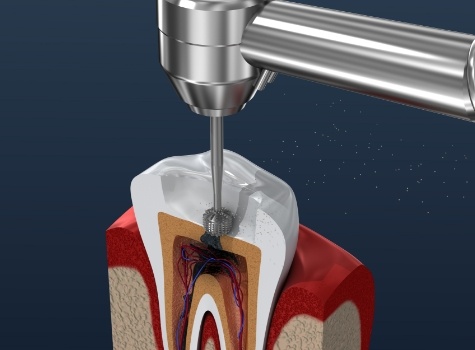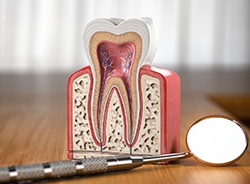Root Canal Treatment – Hoover, AL
How Root Canals Save Your Tooth

Root canal treatment has become one of the most common dental procedures today. In fact, dentists perform more than 14 million annually, making them far more common than most people would think. One of the reasons why this treatment is performed so often is because it’s one of the most effective solutions to saving natural teeth as well as helping you save costs on more complex restorative treatments. Keep reading below to learn more about root canal treatment in Hoover and why it's nothing to be afraid of!
Why Choose Moulton Dentistry of Hoover for Root Canal Treatment?
- Advanced Ultrasonic Enhances Success
- Dentist and Team Members Provide Highly Personalized Care
- Natural, Lifelike Restorations Used to Cover Treated Teeth
Do I Need Root Canal Treatment?

Root canal treatment is designated for the center of your tooth where the pulp lies. As a collection of blood vessels, pulp works to build the surrounding tooth. However, if trauma inflicts the tooth, whether it’s through decay, large chips or cracks, or multiple dental procedures, it can become infected. Infection symptoms include noticeable injury to the tooth, facial swelling of the tissue surrounding the tooth, a pimple-like bump on the gums, and discomfort or sensitivity when exposed to extreme temperatures, particularly in the teeth and gums. If you notice these symptoms, or any other abnormal dental symptoms, schedule an appointment at our Hoover dental office right away.
The Root Canal Process

Dr. Moulton will likely recommend non-surgical treatment if you experience any of the previously mentioned symptoms. This will work to eliminate the diseased pulp, restoring the look, health, and function of your tooth in the process. To remove this damaged pulp, the root canal is thoroughly irrigated and then sealed and covered with a dental crown. To ensure you don’t feel any discomfort throughout the treatment process, we will use a local anesthetic to thoroughly numb the area of your mouth we’re working on.
The Benefits of Getting a Root Canal

Below, you’ll find a few of the many benefits of root canal treatment:
- In most cases, success for root canal treatment reaches 90 percent.
- With this treatment comes local anesthesia to make you feel comfortable.
- The entire treatment process can usually be completed in just two visits.
- The restoration used to protect the tooth is lifelike in look and feel.
- This emergency dental treatment can prevent your tooth from being extracted.
It’s also worth noting that, if indicated, we can provide nitrous oxide analgesia as well. Not only does this mean you’ll be able to drive yourself home after treatment, but you’ll also be able to restart your normal routine!
Understanding the Cost of Root Canal Treatment

While it’s important to have your infected tooth treated as soon as possible, you should make sure that you have an accurate idea of what the cost of your care will look like before you commit to anything. We’ll be able to give you a reliable estimate once we’ve had the chance to examine your mouth, but in the meantime, here are the basics of what you need to know when it comes to the cost of root canal treatment.
Factors That Can Affect Root Canal Treatment Cost

In many cases, the cost of a root canal treatment depends on which tooth is involved. Compared to your front teeth, the molars near the back of your mouth have more roots and more complex inner anatomies. This generally makes them more difficult to clean out, resulting in a more costly procedure.
On top of that, you may also need to make room in your budget for additional services. In particular, you will likely need to get a dental crown to repair and protect the treated tooth; said crown will carry its own cost.
Finally, it’s worth noting that we may need to refer you to an outside specialist if your case is found to be particularly complex. If this happens, the cost of your care will be determined by the specialist’s own pricing structure.
Is it Cheaper to Pull My Tooth?

Having a tooth extracted does tend to cost less than a root canal treatment. On the other hand, an incomplete smile can lead to alignment issues and other complications, and replacing an extracted tooth comes with additional costs to consider. A root canal treatment will let you avoid these problems, which can ultimately make it the better option for your oral health as well as your bank account.
Does Dental Insurance Cover Root Canal Treatment?

Most dental insurance plans will at least partially cover root canal treatment. The exact percentage can vary depending on which plan you have, so it’s a good idea to review your benefits and make sure that you fully understand your coverage. Our team will gladly file any necessary claims on your behalf, and we’ll be happy to review your plan with you to clarify any details that you may be confused about.
Other Options for Making Root Canal Treatment Affordable

There’s more than one way to make root canal treatment more budget-friendly. For example, you can sign up for our in-office dental membership plan, which comes with discounts on many services. Another option is to apply for CareCredit financing, which lets you pay for your care in more convenient monthly installments. Finally, if you think you require a root canal treatment but need to schedule an appointment to find out for sure, you can take advantage of our practice’s special offer for a $39 emergency visit.
Root Canal FAQs
How Can I Prepare for My Root Canal?
You might be feeling sore following your procedure, so we recommend having a healthy meal before you arrive. However, it’s best to avoid alcoholic beverages or tobacco products because they contain ingredients that can interfere with the numbing medication.
Then, it’s a good idea to take a pain reliver, like ibuprofen, before you arrive so it kicks in by the time we begin your treatment. You’ll also want to get a good night’s sleep beforehand, to ease any anxious nerves and boost your immune system.
How Long Does a Root Canal Take?
Are you curious how long your procedure will last? This service can often be completed in a single appointment, though sometimes it’s completed over two visits. In that case, we’ll likely place an antibacterial medicine over your troublesome tooth to alleviate aches and kill bacteria, then have you return another time to clean the inside.
Usually, root canals take anywhere from 30 to 90 minutes, though it depends on your unique circumstances. For instance, if you have multiple teeth requiring treatment, it will likely take longer. Also, molars are harder to access and have more roots to clean, which can potentially elongate your visit.
How Long is Root Canal Recovery?
Although it can vary somewhat based on your unique circumstances, many patients can safely resume school or work the day after their procedure. However, if your job requires intense periods of physical labor, you may need to take a few days off. Vigorous exercise diverts blood from the site, which slows the healing process.
Then, you can expect to feel tender and sore for a few days. Our team in Hoover usually recommends sticking to softer, milder foods that won’t irritate your gums, like mashed potatoes, applesauce, or scrambled eggs.
Usually, you can expect to brush and floss twice daily as normal, though you should be gentle and take care when cleaning near your treated tooth.
How Much Pain is Normal After a Root Canal?
It’s also normal to feel mild to moderate aches and inflammation following your procedure as the local anesthetic wears off. This often lasts for several days before gradually subsiding on its own.
You can typically reduce symptoms safely with over-the-counter medications, like Tylenol or ibuprofen. You should also steer clear of overly hard, crunchy, or spicy foods that could cause additional irritation to your already tender tissues.
